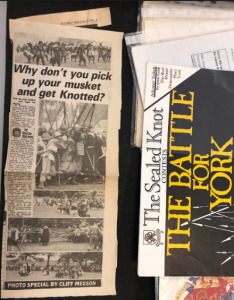July 1, 2022, by Kathryn Steenson
Sealed Knot
This is a guest post by George Davis, 3rd year undergraduate at UoN.
As a Third-Year History student, working on the Sealed Knot collection has been a brilliant opportunity to learn more about archiving and experience working directly with primary material. My role was to work my way through each document in the collection, create a digital record of the items we have and provide suitable descriptions and historical suggestions about each document and how it may be useful. This was my first time working in an archive setting but I found myself quickly feeling comfortable. I think this was extremely helpful for building my skillset in preparation for a career in historical research (hopefully!).

SKU33 Box 14, with a newspaper clipping about a re-enactment and a copy of the Sealed Knot’s newsletter.
Working on the Sealed Knot collection has been an excellent experience! The Knot is an English Civil War re-enactment society and educational charity. It aims to memorialise those lost to the conflict and has been teaching the public about the history of the conflict, its battles, and its people, since the group’s creation back in 1968. In the archive collection, I found programmes from re-enactment days, photographs of members of the Knot, records of letters and meetings between the society’s Inner Council, and countless newspaper articles celebrating their many successes. The Sealed Knot is an amazing example of how to bring history to the general public, working on their documents has really helped me hone my critical analysis skills, my historical imagination, and my confidence with primary documents.
Keeping our history properly archived is extremely important; departments like the Manuscripts and Special Collections team at the university make sure documents and records are kept safely without the risk of damage or deterioration. It is an amazing opportunity to be able to visit an archive and have so a broad and diverse amount of material at your disposal—without archives we would have no way of organising historical records and many would be lost or destroyed. My work also meant that the Knot’s collection has now been recorded digitally. It is so important that historical researchers are aware of the kind of documents that an archive is holding; with the descriptions I have provided, the collection can be properly catalogued and hopefully the Knot will be the subject of future research into public history, memories of war, or historical re-enactments.
I really enjoyed my time learning about the Sealed Knot and archiving. A massive thank you to the UoN archive team for giving me this opportunity, I am confident that the skills I have honed will be of great help in my future postgraduate studies!
To find out more about our collections at Manuscripts and Special Collections, visit our website, follow us on Twitter or Instagram, or read our newsletter Discover. To book an appointment in the Reading Room, please e
mail us mss-library@nottingham.ac.uk.
No comments yet, fill out a comment to be the first


Leave a Reply